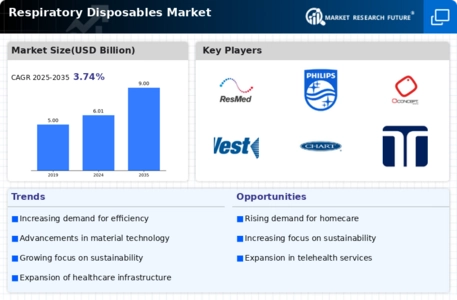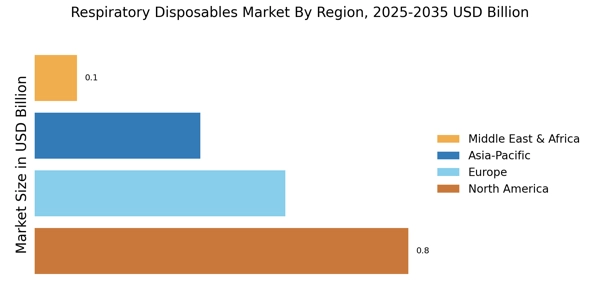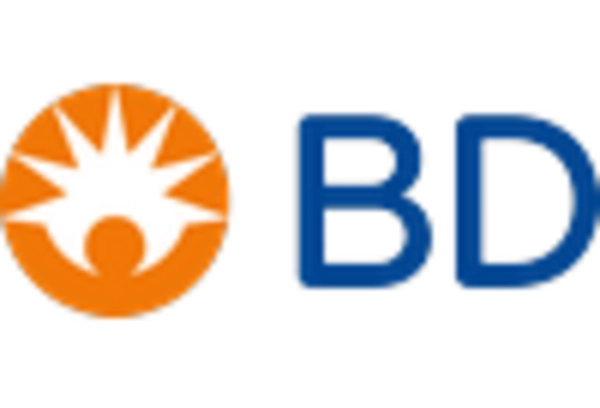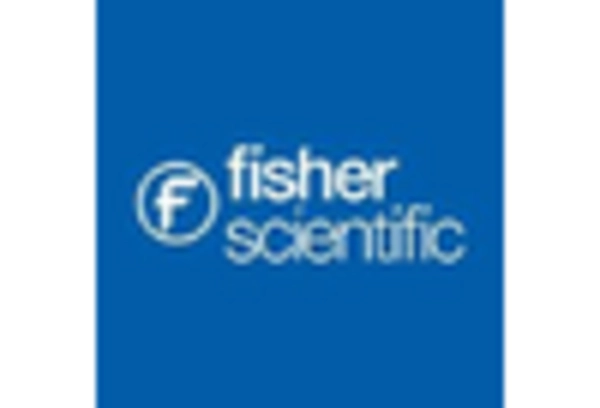Increased Focus on Infection Control
The heightened emphasis on infection control measures is a significant driver for the Respiratory Disposables Market. Healthcare facilities are increasingly adopting disposable products to minimize the risk of cross-contamination and ensure patient safety. This trend is particularly evident in settings such as hospitals and clinics, where the use of single-use respiratory devices is becoming standard practice. Market data indicates that the demand for disposable respiratory products has surged, with a notable increase in sales of items like face masks and ventilator circuits. As infection control protocols continue to evolve, the market for respiratory disposables is expected to grow, reflecting a proactive approach to healthcare safety.
Rising Prevalence of Respiratory Diseases
The increasing incidence of respiratory diseases, such as asthma and chronic obstructive pulmonary disease (COPD), is a primary driver for the Respiratory Disposables Market. According to recent health statistics, respiratory diseases account for a substantial portion of global morbidity and mortality. This trend is likely to escalate the demand for respiratory disposables, as healthcare providers seek effective solutions to manage these conditions. The market is projected to grow at a compound annual growth rate (CAGR) of approximately 7% over the next few years, reflecting the urgent need for disposable respiratory products. As the population ages and environmental factors contribute to respiratory issues, the market for respiratory disposables is expected to expand significantly, indicating a robust growth trajectory in the industry.
Technological Innovations in Respiratory Care
Technological advancements in respiratory care are transforming the Respiratory Disposables Market. Innovations such as smart inhalers, advanced nebulizers, and high-efficiency particulate air (HEPA) filters are enhancing patient outcomes and driving market growth. The integration of digital health technologies, including telemedicine and remote monitoring, is also influencing the demand for disposable respiratory products. As healthcare systems increasingly adopt these technologies, the market is likely to witness a surge in the utilization of respiratory disposables. The introduction of new materials and designs that improve comfort and efficacy further supports this trend, suggesting a dynamic evolution within the industry that aligns with modern healthcare needs.
Growing Awareness of Environmental Sustainability
The rising awareness of environmental sustainability is influencing the Respiratory Disposables Market. As healthcare providers and consumers become more conscious of their environmental impact, there is a growing demand for eco-friendly disposable products. Manufacturers are responding by developing biodegradable and recyclable respiratory disposables, which align with sustainability goals. Market trends suggest that products designed with environmental considerations are gaining traction, potentially reshaping consumer preferences. This shift towards sustainable practices may drive innovation in the industry, as companies seek to balance performance with environmental responsibility. The emphasis on sustainability is likely to create new opportunities for growth in the respiratory disposables market.
Regulatory Support for Disposable Medical Devices
Regulatory bodies are playing a crucial role in shaping the Respiratory Disposables Market. Supportive regulations and guidelines for the use of disposable medical devices are facilitating market growth. Authorities are increasingly recognizing the importance of disposable products in enhancing patient care and safety. This regulatory backing is likely to encourage manufacturers to innovate and expand their product offerings in the respiratory disposables segment. As compliance with safety standards becomes more stringent, the market is expected to benefit from the introduction of new and improved disposable respiratory devices. This trend indicates a favorable environment for growth within the industry, as stakeholders align with regulatory expectations.


















Leave a Comment